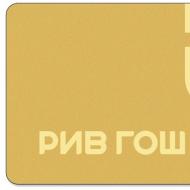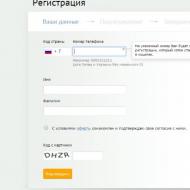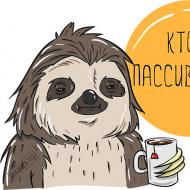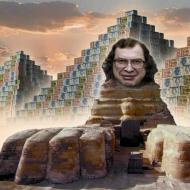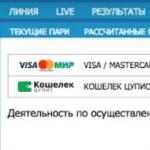
Who is depicted on the Indian banknote. Indian currency. General information about the national currency of India
The earliest money in India was metal coins made from copper or silver. The first banknotes appeared much later, in 1861. At the same time, up to 1949, money from France, England, Spain, Pakistan was in circulation in Indian territory. And only two years after gaining independence, in 1949, India's own money appeared.
The monetary unit in India, according to Indian law, is rupee... One rupee is equivalent 100 paisams.
Commemorative coins and banknotes are sometimes issued for various events and activities in the country.
Once in India, banknotes with a denomination of 0 rupees were issued, which, of course, could not be paid. They were a kind of symbol of the fight against corrupt officials.
Denomination of currency units
Since 1996, the Reserve Bank of India has issued:
- banknotes of 7 denominations: 5, 10, 20, 50, 100, 500, 1000 rupees
- and coins of 6 denominations: 10 paise, 25 paise, 50 paise, 1 rupee, 2 rupee, 5 rupee
The rupee is indicated by the icon Rs... It should be noted that a banknote of the same denomination may have different appearance... These are not fakes, just different modifications of the same banknote are issued. The Reserve Bank is responsible for issuing money. Recently, banknotes are issued with more and more reliable security.
It is prohibited to import and export Indian rupees, and foreign currency can be imported and exported without restrictions.
Material and appearance of money
All coins are round. Coins are made most often from steel or aluminum. All coins feature the Indian coat of arms.
The banknotes have one distinctive sign: they all contain an image on the obverse Mahatma Gandhi... And they differ in color and images on the reverse.
The 5-rupee note depicts a man plowing a field in a field at sunrise with a tractor. The bill is made in greenish shades. The 10-rupee orange bill depicts a roaring tiger, a rhino and the symbol of India - an elephant.
The 10-rupee orange bill depicts a roaring tiger, a rhino and the symbol of India - an elephant.  The 20 rupee banknote features an exotic Indian landscape: palm trees, sea, clouds. The bill has reddish tints.
The 20 rupee banknote features an exotic Indian landscape: palm trees, sea, clouds. The bill has reddish tints.  50 rupees - lilac, it depicts the building of the Parliament of India.
50 rupees - lilac, it depicts the building of the Parliament of India.  The 100 rupee banknote depicts mountain peaks. That is why the banknote is made in blue colors.
The 100 rupee banknote depicts mountain peaks. That is why the banknote is made in blue colors.  The five-thousandth bill depicts a group of people led by M. Gandhi. The banknote is yellow.
The five-thousandth bill depicts a group of people led by M. Gandhi. The banknote is yellow.  The 1000 rupee red banknote depicts the symbols of the country's industry and economy.
The 1000 rupee red banknote depicts the symbols of the country's industry and economy. Where and how best to exchange money in India
Arriving in India, you will surely face the question of where to exchange currency. This is a very important question.
Please note that you should only change currency in specialized places:
- at the bank (there you need a passport for exchange),
- in the airport,
- at exchange offices.
In india, many establishments can have problems with changing large bills. Therefore, during the exchange, you can ask that part of the amount be given to you in small bills. Do not forget to check the appearance of the bills and count the cash without leaving the place of exchange.
Bring better dollars , since they can be exchanged everywhere and at a more favorable rate.
Remember that you should not exchange currency where a taxi driver or hotel administrator offers you to exchange: you can exchange money at an unfavorable rate or even lose it.
Always take and keep your receipt when exchanging money or withdrawing from an ATM. It can be useful to you when exchanging rupees for other money, if at the end of the trip you do not spend all the rupees.
You can bring money both in cash and plastic cards... Travelers checks should not be used, this method has already outlived its usefulness, and it is simply not safe.
If you decide to use the card, then before the trip, check with your bank if your card is serviced in India.
 It would be wise to take cards of two systems with you: Visa and Mastercard since some ATMs accept only Mastercard, and some - Visa.
It would be wise to take cards of two systems with you: Visa and Mastercard since some ATMs accept only Mastercard, and some - Visa.
Better to use a card with a chip: you can use it only by entering a pin code, which, in turn, is safer.
If it happens that you lose your card, immediately call your bank and block it.
Most ATMs have employees. You can ask them if the ATM accepts your card or not. This information is usually written on the ATMs themselves.
There are many ATM machines in India that only accept Indian cards.
Read the notifications on the ATM screen carefully. Some ATMs charge a fee for accessing foreign account... To avoid this, use some other ATM.
With a bank card, you can also pay for purchases in many stores in India. But at the same time, a small commission is usually charged additionally.
Tinkoff multicurrency bank card for a trip to India
It's 2020, which means that monetary transactions abroad are becoming easier and easier, including in India.
Today, the most optimal way to use money in Goa is to use multicurrency bank card Tinkoff Black.
The action plan is as follows:
- We go to the site https://www.tinkoff.ru/, leave a request for Tinkoff cards Black. She will have a main ruble account and additional accounts in the currencies you need.
- After 2-3 days, a courier arrives at the address you specified and gives you a card.
- Link the Indian rupee account to the card through the application or Internet Bank.
- From the main ruble account, transfer the amount you need to the rupee account.
- Before traveling to India (via the app or Internet Bank), make your rupee account the main one.
Everything is ready! Now you can pay and / or withdraw money from any ATM in India, bypassing currency conversion.
For security reasons, indicate the dates of your trip so that the Bank is aware of and does not block access when you carry out monetary transactions abroad.
To replenish a ruble account without a commission, you can link a Sberbank card.
Multi-currency service debit card Tinkoff Black costs 99 rubles. per month or free of charge in the following cases:
- A deposit was opened in the amount of at least 50 thousand rubles
- The card has an irreducible balance of 30 thousand rubles
Very much about who discovered India?
Thus, in all major tourist cities, it will not be difficult to use a card and exchange currency. ATMs and exchange offices are there literally at every step. But in small towns and villages it is better to have cash with you, mostly of small denomination.
The national currency of India is the Indian rupee (INR). One rupee is divided into 100 coin-pais.
The exchange rate of the Indian rupee to the ruble is approximately 1: 1 (1 rupee = 1 ruble), which is very convenient for calculations. If you come across different banknotes of the same denomination, do not be alarmed - both old and new are in use, they are accepted the same way.
What currency should I take with me to India?
Ideally, take rupees with you right away, but finding them in Russia is not easy.
Rubles are not accepted in India, it is more difficult to exchange them for rupees than euros and dollars. American currency is accepted much more readily, so it is better to take dollars to India. There are exchange points in all major cities - go to the bank or find the signboard "Money exchange" (if there is no such signboard, the exchange is considered illegal).
Keep your ears open, there are many pickpockets in India who can be waiting for you at the ATMs. We do not recommend carrying large bills with you and keeping all your money in one place.
Cashless payments
To pay off by credit card in India it is a real problem. Cashless payments are possible only in large cities; in most tourist places, only cash is accepted. But in India (especially in Goa) there are many ATMs where you can withdraw money.
In order to avoid surprises, it is better to clarify the conditions for withdrawing money in advance - there is a risk of paying a commission to your own and local bank.
The most important question that travelers visit when planning a trip to Goa: currency. Indeed, in order to calculate the travel budget and not be trapped on arrival in India, it is better to study the nuances of the money market in advance. A fresh currency exchange rate in Goa is available on almost all thematic sites, including on the official pages of central banks. It is updated daily and it is easy enough to calculate how much to take with you. It is more difficult to decide which money is more convenient to use: cash or on plastic cards?
What is the currency in Goa
The official currency of India, the only one allowed in circulation, is the Indian rupee. In the international classification, they are designated INR.
All paper money in Goa has an image of Mahatma Gandhi on one side. Denomination: 1, 5, 10, 20, 50, 100, 500, 2000 rupees.
In November 2016, a reform was carried out: banknotes of 500 and 1000 rupees of the old model were withdrawn from circulation. The situation with the money market at that time was quite turbulent, and even critical for tourists: huge queues, an overnight cash collapse. The news broadcasting the speech of the Prime Minister of India practically stopped the work of the banking system.
At the moment, the problem is still not resolved. Experienced tourists recommend not to change all the currency for rupees at once and try not to take big money in exchange offices. Because the only way to pay is often cash dollars. Despite the fact that their circulation in India is outside the official monetary circulation.
What currency to take in Goa
580 * 400 goa 13 block
The currency that will provide you with relative peace of mind in Goa is dollars. Just in case, stock up on banknotes of different denominations. They are accepted not only by exchangers and banks. Taxi drivers, guides, shek owners will willingly take dollars in payment. Of course, this is officially prohibited, but money turnover in India has a lot in common with the domestic one.
Euros are held in lower esteem here, that is, it will not be possible to pay freely, unlike dollars. But changing them is easy.
Arriving from the countries of Southeast Asia, you will not be left without money. In addition to dollars and euros, you can exchange currencies of neighboring countries in exchange offices.
If you prefer to pay by plastic card Please note that in Goa, trade and services are almost entirely cash-driven. The towns are small here. ATMs in Goa are in all resorts, but they do not always work smoothly: money runs out at the most unpredictable moment.
It cannot be projected into the future, but in November 2016, a strict restriction on cash withdrawals was set - up to 2.0-2.5 thousand rupees at a time. At the moment, it is allowed to withdraw no more than 10.0 thousand rupees. It is not a fact that this situation will not happen again in November 2018.
Currency exchange
The exchange of rupees for Goa will not be difficult at all. The state is completely tourist-oriented. The only difficulty is the course. It is different everywhere. Even taxi drivers will take currency in their own way, only at the exchange rate available to them. Everywhere, with the exception of banks and official exchangers, be sure to bargain.
The exchange rate of the rupee in relation to hard currencies is a loose concept for Indians. It even depends on the denomination of the money exchanged.
Where is the best place to change money in Goa
Arriving in Goa, the first impulse of a tourist will be to change currencies at the airport. It is logical, especially since you need to somehow get to your destination, and therefore, acquire rupees. It is important not to make mistakes and not immediately exchange all the cash for local currency: the dollar exchange rate at the airport is extortionate.
Change exactly as much as you need for a trip to your chosen hotel or village on the coast. The amount required for a taxi can be checked at the prepayment counter. Taxi drivers will willingly take in dollars, but be sure to bargain. This money is enough for a couple of days of comfortable life in Goa, so it is better to choose the route by public transport. For buses with multiple transfers, you will need no more than 100 rupees.
A good dollar exchange rate will be given to you in travel agencies. There are offices in all coastal towns and cities. In Morjim, you can even exchange rubles for rupees. The course is floating. On average, it is 1: 1. As an option, there are agents in Goa who accept transfers to cards of Russian banks and issue cash rupees right away.
Exchangers sometimes do not agree to change banknotes with a denomination of less than $ 100 or make an additional markup. For Goa, this is in the order of things.
Goa ATMs
In India, next to an ATM, you can find a colorful guard in the form of an Indian soldier in full uniform with rare samples of firearms.
ATMs in Goa are slightly different from ours. The card is readable without being absorbed inward. The menu is simple and straightforward, in English. MasterCard and Visa are accepted.
The same travel agencies offer an alternative to ATMs. Most of them have a cash-advance service. However, this is not safe, it is better to play it safe and change money.

No commission ATMs in Goa
It is unlikely that it will be possible to withdraw cash in Goa through an ATM without a commission. Because the ATM network State bank India (SBI), as well as the Bank of India (BOI) and Canara Bank, where it is guaranteed that there will be no additional costs for withdrawals, do not cover the needs of tourists: they have many branches, but not very many ATMs.
Experienced travelers recommend that you carefully study the rates of the issuing bank. Typically, they all take either a commission or a fixed percentage. Cashing out with MasterCard will be cheaper than with Visa cards... The size is in the range of 90-150 rubles.
Depending on which Indian bank owns the ATM, you may be charged an additional fee. The most common ATMs are ICICI, HDFC, and Axis and they make tourists poorer by about Rs 200 per transaction. Although they warn about this before your final consent to hold it.
Do not agree to a direct exchange in rubles from a card: the commercial rate will be a real shock. It is much safer to conduct a transaction through an intermediate exchange for dollars.

Collapse monetary reform, which began in November 2016, despite assurances from the beginning of the year to remove restrictions, continues to this day. Due to the huge amount of old-style rupees in the hands of the population, there is no guarantee that the printing press will cope with the load in the near future. Although by the new season, which starts in November 2018, the situation should be exhausted.
Note that experienced travelers advise:
- The restriction on cash withdrawals from cards in some ATMs is about 10 thousand rupees. Take some different cards if you don't want to take dollars with you. Store them in different places to avoid losing your airbag.
- Examine the money carefully. Not worth using official rate dollars when exchanging for old-style bills. Haggle. Experienced travelers recommend taking at least 100 rupees for 1 dollar. This is due to the fact that when making payments in markets, in sheks or cafes, old money is accepted with a large discount.
- Change large denomination dollars for small ones in advance. This is the most the best option for calculations until you get your bearings.
Everyone decides for himself to take currency or cards with him. For a short trip of a couple of weeks, you can take dollars with you. For long-term stays, plastic is better: it is easier to carry it with you, and not to worry about your money.
Going to Goa, monitor the situation with the money market. There is no need to wait for news this season, but in the new one, which will begin in November 2018, new innovations are not excluded.
The national currency of India is the rupee. Currency issue is controlled by the Federal reserve bank India. The most commonly used symbols for the rupee are Rs and ₨. The ISO 4217 code for the rupee is INR. One rupee equals 100 paise.
In many parts of India the rupee is also called “rupayi”, “rupaye”, “rubai”, and also in some other words, from the Sanskrit word “rupyakam”. Raupya means silver; "Rupyakam" - a silver coin. However, in West Bengal, Tripura, Orissa and Assam, the Indian rupee is known by a name derived from the Sanskrit "thangka".
In January 2008, the official exchange rate against the US dollar was 40 rupees per dollar.
Notation
As standard in Indian English, large sums Indian rupees are counted in thousands, tens of thousands (lakhs) (100 thousand = 105 rupees, numerically 100,000), crores (100 lacquers = 107 rupees, in numbers - 10,000,000) and arawbahs (100 crores = 109 rupees, in figures - 1,000,000,000). The use of terms such as “million” or “billion”, as in Standard British or American English, is much less common.
For example, 12,584,729.25 Indian rupees should be pronounced as one crore twenty five varnishes eighty four thousand seven hundred twenty nine rupees and twenty five pais (see Indian numeral system).
Story
India was one of the first countries to use coins (around the 6th century BC). It is believed that the first rupee was introduced by Sher Shah Suri (1486-1545), and it was equal to forty copper pieces (pais). The first paper rupees were issued by the "Bank of Hindustan" (1770-1832), then " Main bank Bengal and Bihar "(1773-75, founded by Warren Hastings) and the Bank of Bengal (1784-91).
During British rule and the first decade of independence, it was divided into 16 annas. Each Anna, in turn, was divided into 4 paise or 12 shares. In 1815, the government of Madras also issued a currency "fanam", one fan was equal to 12 rupees.
Historically, the rupee, which takes its name from the Sanskrit rupee, which means silver, was a silver coin. This fact had dire consequences in the 19th century, when the world's strongest economies were based on gold. The discovery of large reserves of silver in the United States and various European colonies lowered the value of silver relative to gold. Suddenly, there was a situation where the Indian currency became uncompetitive. This event is known as "the fall of the rupee"
In 1898, the rupee was pegged to the gold standard by the British pound, at the rate of 1 rupee = 1 shilling 4 pence (i.e. 15 rupees = 1 pound). In 1920, the rupee rose to 2 shillings (10 rupees = 1 pound). However, in 1927 the exchange rate fell again, this time to 1 shilling and 6 pence (13⅓ rupees = 1 pound). This rate was held until 1966, when the rupee was devalued and the ratio was 7.5 rupees to 1 US dollar (at this time, 1 rupee was equal to 11.4 English pensions). This rate held until the devaluation of the dollar in 1971.
The Indian rupee replaced the Danish Indian rupee in 1845, the French Indian rupee in 1954, and the Portuguese escudo in 1961. Following independence in 1947, the Indian rupee replaced all the currencies of the former autonomous states. Some of these states issued rupees of equal value (relative to British pound) (for example, Travanqor rupee). Other currencies are the Hyderabad rupee and Kuch kori.
International use
In connection with the division, Pakistani rupees appeared, although Indian coins were used first, and Indian banknotes were then simply reprinted in Pakistan. Previously, the Indian rupee was official currency other countries such as Kuwait, Bahrain, Qatar, UAE and Malaysia. The Persian Rupee (XPGR), was introduced by the Indian government instead of the Indian rupee for circulation only outside the country (according to the Federal Reserve Bank of India act of May 1, 1959). The creation of a separate currency was an attempt to lessen the pressure on India's foreign investment from gold smuggling. After the depreciation of the rupee in India on June 6, 1966, these countries still continued to use it, and Oman, Qatar and the modern United United Arab Emirates, replaced the Persian rupee with their own currencies. Kuwait and Bahrain did so in 1961 and 1965, respectively.
The Indian rupee is also linked to Bhutan's currency, the ngultrum. Indian rupees accepted in Nepal, near the Indian-Nepalese border and in some Indian stores in the UK.
Coins
East India Company, 1862
Each of the three districts established by the British East India Company (Bengal, Bombay and Madras) had their own monetary system until 1835. All three types of rupee, graduated to ⅛ and 1⁄16 rupee, were silver. There was also a 2 rupee coin in Madras.
Copper coins were more varied. In Bengal, there were coins in denominations of 1 share, ½, 1 and 2 paisa. In Bombay - 1 share, ¼, ½, 1, 1½, 2 and 4 paisa. In Madras there were copper coins of 2 and 4 paisa, 1, 2 and 4 paisa, the first two being called ½ and 1 dab or 1⁄96 and 1⁄48 rupee. Note that Madras also released to fans prior to 1815.
All three districts produced gold mohurs and parts thereof, including 1⁄16, ⅛, ¼ and ½ in Bengal, 1⁄15 (gold rupee) and ⅓ (pansiya) in Bombay, and ¼, ⅓ and ½ in Madras.
In 1835, a unified monetary system was introduced. It consisted of copper 1/12, ¼ and ½ annas, silver ¼, ½ and 1 rupees and gold 1 and 2 mohurs. In 1841 a silver coin was added, in denomination 2 annas, and then, in 1953, a copper coin - ½ paisa. This system lasted until 1862, even after the British royalty took over the company.
The currency of India is the rupee.
Average rupee exchange rate 1 RUB ~ 1.7 Rs
India is one of the cheapest countries in Asia. A feature of Indian trade is the presence of a double price bar - for local and foreigners.
In the provincial shops of India, as well as in the markets, it is often difficult to obtain
change from large bills, which are given when exchanging dollars for rupees.
Try to get some of the rupees when exchanging small banknotes.
Despite the presence in Indian stores of a large group of goods with fixed price(MRP - the price is on the price tag) and the signs on some stores about the sale of goods at fixed prices (Fixed Price Shop), local traders tend to necessarily inflate the original price for foreigners. The minimum of such “markups” is 30-50% of the usual price, the maximum “markups” can increase the price by 100-200 times. In order to even up prices a little, guests of India have to in most cases desperately bargain.
Tipping in India
Tipping is optional in India. However, given the extremely low level Most earnings, remember that tips are often the main source of livelihood for many service workers, especially minors.
The amount of tips in India is determined individually - depending on the level of service. The average tip in restaurants in India is 10% of the bill, sometimes included in the bill as a “service charge”.
For small services in hotels of mid and low price category in India, the tip can be 10-20 rupees. In more expensive hotels in India, the average tip is $ 1.
Answering the question - how much money to take to India most seasoned travelers recommend counting on minimum amount spending $ 15-20 per day.
Approximate prices in India
- Loaf of bread - $ 0.4
- Milk 1 l - $ 0.6
- Cheese 1 kg - $ 4
- Mango 1 kg - $ 0.8
- Bananas 1 kg - $ 0.1
- Dinner for two in a restaurant - $ 10-12
- Lunch at a cafe - $ 3-4
- A cup of tea in a cafe - $ 0.1
- Whiskey "Aristokrat" 1 l - 5 $
- Rum "Old Monk" 750 ml - $ 3-12
- Rickshaw ride - $ 0.7-2
- Rent a car with a driver for half a day - $ 24-26
- Travel by intercity bus 100 km - 2 $
- A ticket to museums or temples - $ 4-17
- Indian shirt - $ 4
- Double room in the hotel - $ 18-36 per day
- Apartment rent - $ 120-180 per month
Currency exchange in India
Payment for goods and services in India is made only in local currency - rupees. Best Currency for exchange for rupees are US dollars.
Currency exchange in India it is recommended to produce at banks, as well as at airports and official exchange offices. Traveler's checks can also be cashed in banks in India (the most popular are Thomas Cook and American Express). Most of the hotels in India also have currency exchange offices, but the rupee rate in them is significantly overvalued.
Dirty and tattered rupees that you can be given in exchange, rather
will not be accepted in many restaurants and shops in India.
Be careful and ask to exchange “substandard” bills for new ones without leaving the cash register.
To exchange currency in India, you will need show your passport... After the currency exchange, you will be issued a receipt. It must be kept until the end of the trip in order to make a return exchange at the Indian airport (no more than 25% of the total amount exchanged) or to purchase a ticket for railway transport (sometimes they are asked to present).
Do not succumb to the persuasion of hotel staff or taxi drivers, change currency in
the "profitable" exchanger familiar to them - the result in most cases will be
deplorable for your budget.
Although banks in India conduct transactions with cards of well-known banking systems(Mastercard, American Express, Visa), this does not change the fact that India is ranked first in the list of countries with high level credit fraud... In this regard, use by credit card in India to pay for services strongly Not recommended, even in large cities(except for paying for tickets at the official representative offices of airlines).
Banks of India
Banks of India most of them work on weekdays from 10:00 to 14:00, and on Saturday from 10:00 to 12:00. Some branches of Indian banks in major cities are open on Sundays. June 30, December 31, as well as on national holidays, all banks in India are closed.
Major banks in India
State Bank of India- the largest state-owned network of banks in India - more than 15,000 branches in the country and abroad.
Bank of India is the leading state-owned banking network in India, with more than 3100 offices in all states of India, as well as branches around the world.
Bank of Baroda is one of the leading international banks in India, with more than 3000 branches scattered throughout the country.
The Federal Bank- the biggest private bank India.
ICICI Bank- the second most important private bank in India - more than 2,000 branches and 5,000 ATMs in the country.
Axis Bank is one of the largest ATM networks in India.


